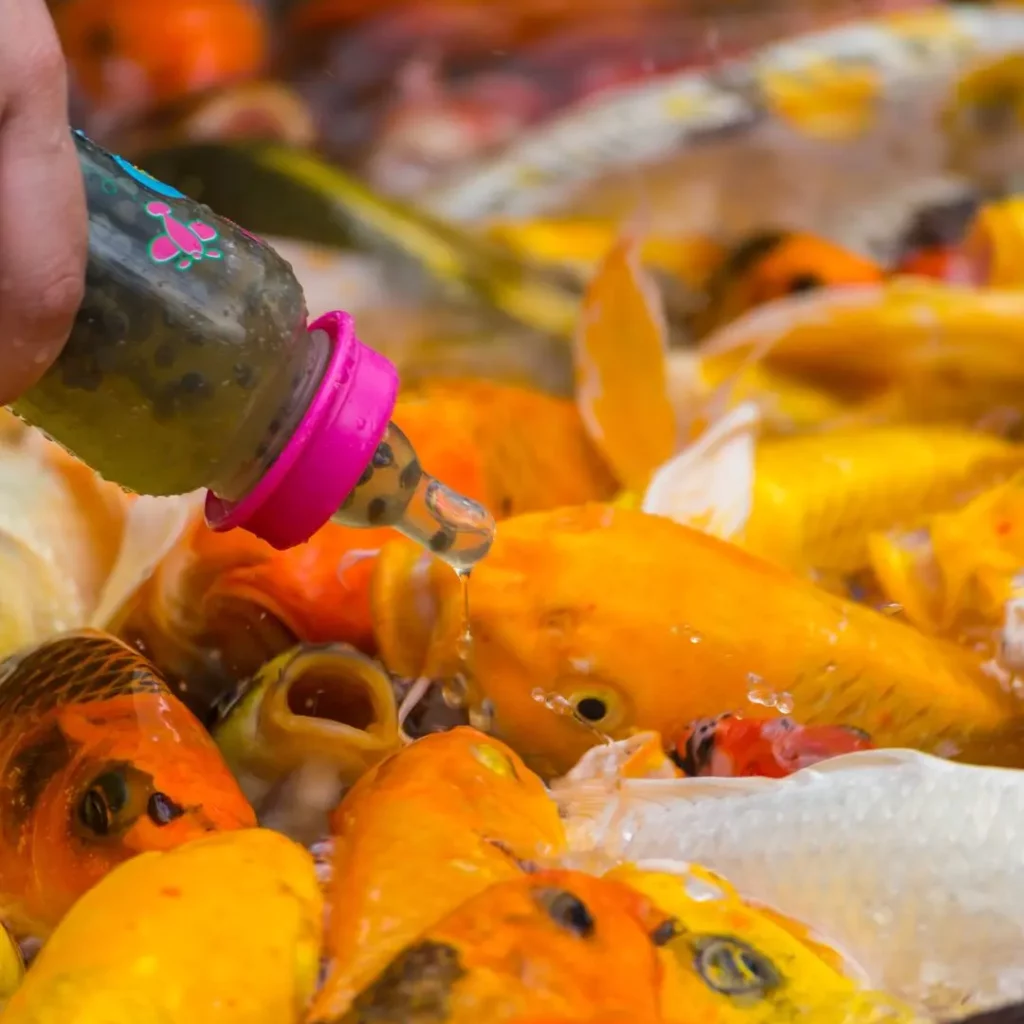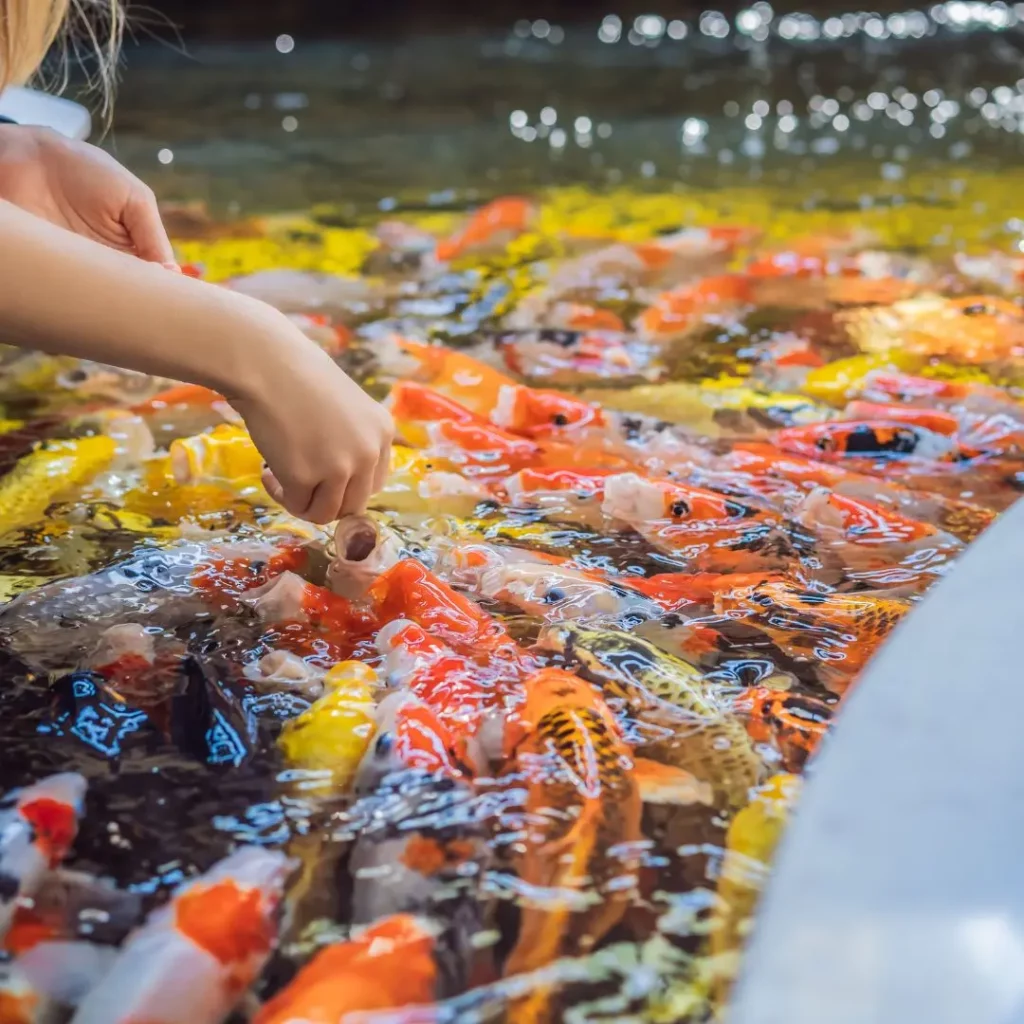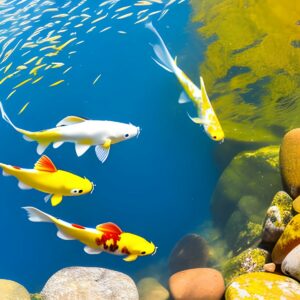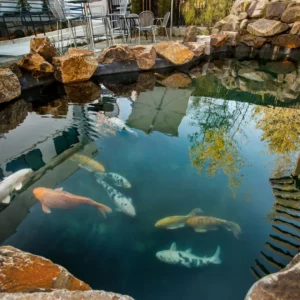Koi fish are omnivorous, meaning they can eat almost everything we do, making their feeding needs quite convenient.
However, it’s important to note that Koi fish don’t have stomachs and are cold-blooded, meaning they can’t digest the food as fast and as effectively as we can.
That’s why Koi fish require food that:
- Improves digestion
- Supports the immune system
- Packs a lot of vitamins and minerals but not many calories
In this article, I’ll list all the foods you can feed to your Koi, explain their benefits, and explain some important guidelines you should follow when feeding your Koi fish.
Let’s dig in!
What Do Koi Fish Eat: Table of Contents
What Do Koi Fish Eat In the Wild?
Koi fish eat:
- Algae
- Aquatic plants (underwater vegetation)
- Seeds
- Larvae
- Insects
- Worms
- Crustaceans
They rely on their fleshy barbels to sense the bottom since they lack real teeth. This means they eat pretty much anything they can find in the water.
Imitating or at least trying to simulate a similar type of this diet in captivity is critical in maintaining your Koi fish’s overall health.
What Food Should You Feed To Your Koi Fish?

Here’s a list of the best, healthiest food that provides all the nutrients your Koi fish needs to thrive.
| Commercial Fish Food | |
| Shrimps (preferably brine shrimp and red-form Gammarus shrimp) | |
| Wheat Germ | |
| Treats | |
| Vegetables | Broccoli Cauliflower Lettuce Garlic Leek Squash |
| Fruits | Watermelon Grapes Kiwi Oranges Mandarins Strawberries Blueberries |
| Other Healthy Treats | Whole-wheat bread Hard-boiled eggs Cooked rice |
Note: Feel free to take a screenshot of this table, as it can be quite convenient to have it ready on-the-go and save time. ⏱️
Commercial Fish Food
| Examples of High-quality Fish Food | Benefits of High-quality Fish Food |
| Kaytee Koi’s Choice | Supports muscle development Strengthens immune system Strong bones Beautiful skin Improves color and vibrancy Eeasier and smoother digestion Faster growth |
| Tetra 16485 Koi Vibrance Sticks Fish Food | |
| Blue Ridge Fish Food |
The main source of food for your Koi fish should be store-bought, high-quality fish food. It contains a carefully crafted combination of nutrients promoting Koi’s health.
Commercial fish food makes it incredibly convenient to feed your Koi fish as it contains all the necessary nutrients they need in bite-sized pieces such as pellets, flakes, and bars.
Here’s a quick breakdown of its beneficial nutrients and health benefits:
- Protein: The foundation of this food lies in its high-quality protein, which supports the development of strong muscles and promotes healthy growth in your Koi. Consider it a delightful gym membership that keeps them robust and lively.
- Vitamins: Your Koi’s health is safeguarded by essential vitamins, acting as diligent soldiers. These fortified foods provide a vitamin boost, strengthening their immune system and ensuring their overall well-being.
- Minerals: Carefully balanced pellets contain calcium and phosphorus, essential for maintaining strong bones. These pellets are like miniature mineral mines, ensuring your Koi’s skeletal system remains sturdy and well-balanced.
- Color Enhancing Nutrient(s): Natural color enhancers, such as astaxanthin, are often included in commercial foods to intensify the vibrant scales of your Koi. Consider it a secret ingredient that unveils their inner beauty and enhances their visual appeal.
The fish food for Koi comes in different types/shapes:
- Pellets – best type and suitable for most Koi. Just make sure the size of the pellets is right for the size of your Koi fish, as smaller ones may struggle to eat it properly.
- Flakes – suitable for Koi of all sizes and ages but the most suitable for the smallest Koi and fry (babies)
- Bars – excellent for large Koi but even smaller ones can nibble on them.
Floating or Sinking Food?
You can also categorize most of these fish foods by whether they’re floating or sinking type of food. But what’s the difference? It’s quite simple.
Floating type is a great way to make feeding time more fun for yourself and easier for your Koi. Most Koi who grew up in captivity prefer this way of feeding.
On the other hand, sinking fish food is more beneficial for mental and physical stimulation, as finding and eating it is more engaging for your Koi – just like in their natural habitats.
However, it’s quite difficult to observe how much food your Koi fish ate when it’s sinking, so you won’t be able to tell whether there are any leftovers. This can pose a risk as rotten food can easily ruin the water quality in your pond and make your Koi sick.
The Importance of Choosing Quality Food for Your Koi Fish
The health and well-being of your fish greatly depend on the food you provide them.
The best Koi fish food uses fresh ingredients packed with vital nutrients and helps maintain the health of your Koi.
Note: Top-notch Koi food should be slow-sinking, requiring your fish to exert more effort while eating. This promotes the necessary exercise for their overall well-being.
On the other hand, low-quality Koi fish food contains cheaper, artificial ingredients. Feeding your Koi with this type of food can lead to health issues.
Note: Low-quality Koi food tends to sink quickly, making reaching it easier for your fish. However, this can result in obesity, leading to other health issues.
These foods also cause a lot of waste putting additional pressure on your filtration system.
Shrimps
| Best Shrimps To Use | Benefits of Shrimps |
| Brine Shrimp | Muscle development Accelerates growth Improved color and vibrancy |
| Red-form Gammarus Shrimp |
If you want to boost your Koi’s diet, consider adding Brine shrimp (or Gammarus shrimp) to their menu.
- Brine Shrimp: Artemia, commonly known as Brine shrimp, is a type of aquatic crustacean. They come live or frozen from both freshwater and saltwater environments. The majority of experienced pond keepers feed this shrimp to their Koi frequently.
- Red-form Gammarus Shrimp: Gammarus is a distinct species of shrimp that does not fall under the Artemia genus. They serve as an excellent food option for Koi fish, although they are not as commonly chosen.
These miniature marvels are nutritional powerhouses packing a punch of vital nutrients! Here are some health benefits you can expect from adding these to your Koi’s daily diet:
- Muscle Builders: Both shrimps are protein powerhouses, providing the building blocks for strong muscles and healthy growth in your Koi.
- Healthy Fat Powerhouse: These shrimps contain healthy fats, especially unsaturated fatty acids, for maintaining Koi’s overall health.
- Immune System Boosters: Vitamins and minerals are like tiny soldiers defending your Koi’s health, and both shrimps are well-stocked with Vitamin B, selenium, and zink. This boost strengthens their immune system, keeping them vibrant and resilient.
- Bone Builders: These tiny crustaceans are a great source of calcium and phosphorus, beneficial for strong bones – ensuring your Koi’s skeletal system stays strong and balanced.
Remember: Variety is key to a healthy diet, so mix these shrimps with your Koi’s regular food in moderation and don’t use them as a primary source of food. Introduce them gradually and monitor their behavior.
Wheat Germ
| Benefits of Wheat Germ |
| Supports balanced growth Better blood circulation Improved color and vibrancy |
Wheat germ is a commonly used food for Koi fish. It’s derived from the sprouting part of wheat – a part that eventually grows into a new plant, which we know as the wheat seed.
Adding wheat germ to Koi’s diet can accelerate their growth. It also serves as a natural source of vitamin E, enhancing blood circulation, increasing the flow of oxygen and nutrients, supporting balanced growth, and aiding in disease prevention.
Treats
Besides regular food, you can always use treats to spend extra time bonding with them and enrich your Koi fish diet.
The healthiest and most popular treat options for Koi include fresh vegetables, fruits, and other types of food like bread crumbs, rice, and animal-based protein sources such as eggs.
Vegetables
| Vegetables | Benefits |
| Broccoli | Improves immune system Healthy skin Blood clotting Nutrient-rich Detoxification Rich in antioxidants – helps with wounds/healing |
| Cauliflower | Rich in antioxidants Better metabolism Promotes digestion |
| Leek | Skin health Blood clotting Bone health |
| Squash | Improves immune system Healthy skin Blood clotting Nutrient-rich Detoxification Rich in antioxidants – help with wounds/healing |
| Lettuce | Fiber source Hydration |
| Garlic | Strengthens immunity Helps in fighting bacteria and parasites |
Although they primarily eat leafy greens, most Koi fish enjoy a variety of veggies. Here are some of the most beneficial options:
- Broccoli: This green powerhouse provides important vitamins such as A, C, and K, supporting the immune system, skin health, sight, and blood clotting. Also, the fiber content keeps their digestive system running smoothly.
- Cauliflower: Is a great fiber and antioxidant source. It promotes healthy digestion and fuels their metabolism. It also contains vitamins B and C, promoting immunity and blood circulation/clotting.
- Lettuce: While not a nutritional powerhouse, lettuce offers hydration, a decent source of fiber, and a satisfying crunch.
- Garlic: Packs allicin, a great assistance in fighting bacteria and parasites. It strengthens their immune system, keeping them disease-resistant and thriving in your pond.
- Leek: Rich in vitamins A and K, it supports skin health and blood clotting, ensuring all systems go.
- Squash: Packed with vitamins A and C, it keeps their eyes sharp and bones strong.
Fruits
| Fruits | Benefits |
Watermelon | Hydration Improves immune system Helps with wounds/healing |
| Grapes | Support metabolic functions Blood clotting Energy boost |
| Kiwi | Strengthens immunity Hydration Energy source Rich in antioxidants – help with wounds/healing |
| Citruses (oranges, mandarins, etc) | Blood clotting Stronger bones Improves immunity Rich in antioxidants – help with wounds/healing Stronger fins and scales |
| Strawberries | Good antioxidants source Blood clotting Stronger bones Stronger fins and scales Better immunity |
| Blueberries | Blood clotting Stronger bones Improves immunity Rich in antioxidants – helps with wounds/healing Stronger fins and scales |
Here are some delicious, healthy fruits that will keep your Koi happy, healthy, and glowing:
- Watermelon: This juicy wonder delivers summer refreshment and packs a vitamin punch with vitamins A and C. It boosts immune function and overall health, while the high water content aids in hydration.
- Grapes: These tiny bursts of sweetness offer vitamins B and K, supporting metabolic functions and blood clotting. The natural sugars provide a quick energy boost, making them a delightful and nutritious snack.
Pro tip: While grapes may seem small enough for Koi, they’re often not. So slice them into smaller pieces to avoid choking hazards.
- Kiwi: This tart treat is a nutritional powerhouse, bursting with vitamin C and dietary fiber. It supports heart health, aids digestion, and strengthens the immune system, benefiting your Koi’s overall well-being.
Note: The strong flavor might not be for every Koi, so offer it cautiously.
- Citruses (Oranges, mandarins, etc): Oranges and mandarins are healthy occasional treats for Koi fish. They’re like vitamin C powerhouses, boosting immunity and helping with wound healing.
Similarly to watermelon, citruses are also good sources of water, providing a great way for extra hydration during high temperatures.
Remember: Remove the rinds, as they can be difficult to digest and potentially upset the pond chemistry as a waste.
- Strawberries: Strawberries pack a lot of vitamins, including A, C, and K. Vitamin A supports the vision and immune function, and Vitamin C acts as an antioxidant and aids in wound healing. At the same time, Vitamin K helps with blood clotting and bone health.
Strawberries have high fiber content, acting as a natural digestive aid. They also contain certain pigments, such as anthocyanins, that can add a subtle vibrancy to their coloration, especially in Koi with red ‘’hi’’ markings.
- Blueberries: Blueberries provide a mix of vitamins and minerals and are packed with antioxidants. They’re bursting with vitamins C, K, and E in particular. Vitamins C and K serve the same purposes as strawberries, while vitamin E acts as an antioxidant and protects cells from damage.
Similarly to strawberries, blueberries also contain anthocyanins. So feeding them to your Koi regularly can brighten up the blue pigmentation.
Other Healthy Treats
| Food | Benefits |
| Whole-wheat bread | Provides energy boost Aids in digestion (depending on amount) |
| Hard-boiled eggs | Builds muscles Supports growth Low in carbohydrates/easy to digest |
| Cooked rice | Better digestion More energy Boosts overall health |
Fresh fruits and veggies aren’t the only type of treats you could give to your Koi. For instance, a few pieces of whole-wheat bread, hard-boiled eggs, and a bit of cooked rice can make a great addition.
Here’s a quick breakdown of these options, highlighting their nutritional benefits and why moderation is key:
- Whole-Wheat Bread:
- Pros: Moderate amounts provide carbohydrates for energy and fiber for digestion.
- Cons: Lacks important nutrients and overfeeding can cause bloating and digestive problems. Uneaten bread can quickly decompose and foul the pond water, potentially harming your Koi.
- Hard-Boiled Eggs:
- Pros: Packed with protein for muscle growth and amino acids for immune system support. Low in carbohydrates/easy to digest, minimizing digestive issues for your Koi.
- Cons: High in fat and cholesterol, so overfeeding can be harmful.
- Cooked Rice:
- Pros: Easily digestible source of carbohydrates for energy and aids in digestion. Rice contains B vitamins and minerals like manganese, offering a slight nutritional boost to your Koi’s health.
- Cons: Overfeeding rice can cloud the pond water and disrupt the ecosystem as it decomposes.Not a complete food source.
Recipe: Koi Crunchies: A Simple & Healthy Treat
Let’s make some delicious Koi-friendly treats!
Ingredients
- 1/2 cup rolled oats (oatmeal)
- 1/4 cup cooked brown rice
- 1/4 cup finely chopped kale or spinach
- 1/4 cup chopped green peas
Instructions
- Preheat oven to 300°F (149°C).
- Line a baking sheet with parchment paper.
- In a large bowl, combine oats, cooked rice, vegetables, and spirulina (if using). Mix well.
- Add a little water, a tablespoon, until the mixture comes together and holds its shape when pressed.
Pro tip: Don’t make it too wet.
- Form small, bite-sized pieces and spread them on the prepared baking sheet.
- Bake for 20-25 minutes or until golden brown and firm. Cool completely before feeding.
To help you out, here are a few serving tips:
- Crumble the cooled Koi Crunchies and sprinkle them directly onto the water’s surface.
- You can store leftover treats in an airtight container in the refrigerator for up to a week.
- Feel free to experiment with different vegetables and grains, ensuring they’re fish-safe.
- Avoid adding spices or salt, as they can harm your Koi.
How to Feed Your Koi Fish?

While it’s critical to understand what foods you should include in your Koi diet, you should also be aware of the feeding guidelines such as food size, quantity, feeding frequency, and seasonal diet adjustments to ensure their optimal health and longer lifespan.
- Food Size: Match the pellet diameter to your Koi’s mouth size. Oversized pellets pose choking hazards, so ensure the food is small enough for your Koi to swallow.
Variety is key! Offer a mix of sizes during each feeding, depending on the size of your Koi.
- Quantity: Resist the urge to overfeed – a common beginner’s mistake. Koi lack stomachs and easily overindulge in their food. Aim for just enough food they finish within a few minutes at each feeding.
Pro tip: Observe their feeding frenzy; once it subsides, stop offering more.
- Feeding Frequency: Adjust feeding frequency based on water temperature. Feed more than three times daily in warm weather and gradually reduce the frequency as temperatures drop.
- Seasonal Diet Adjustments: Your Koi’s metabolism will increase during warm summers, demanding more frequent feeding sessions. Offer a high-protein diet to support your Koi’s growth.
Throughout the cool springs and autumns, reduce feeding frequency and switch to a lower-protein diet for a balanced diet that suits slower digestion.
Koi’s metabolism drastically slows down during cold winters, especially when the water temperatures remain at 50°F/10°C or below. This is when their natural foraging instincts kick in, often leading to metabolic hibernation.
- Use an Auto-feeder: Auto-feeders are an amazing way to keep your fish satiated and get that extra peace of mind. An auto-feeder can feed your fish consistently and on schedule, even when you’re away or busy!
You just have to set precise feeding times and amounts, eliminating the need to manually sprinkle food daily. It also prevents overfeeding by utilizing pre-determined portions.
Never used one before? No problem! I’ve listed some high-quality ones you should consider.
For ponds:
For aquariums:
- Petbank Automatic Fish Feeder for Aquarium
- FREESEA Aquarium Automatic Fish Feeder
And here are some additional tips to keep in mind:
- Unlike us, since they don’t have stomachs, Koi fish feel full after eating small amounts and get hungry quite fast. That’s why it’s important to feed your Koi multiple times a day, in small amounts.
- Maintain consistent feeding times and locations. This creates a predictable routine, minimizes stress, and ensures all Koi get their share.
- Monitor water quality closely. Overfeeding fouls the water with excess nutrients, harming your Koi and requiring more frequent pond maintenance.
- Enrich their diet with occasional treats. Offer chopped lettuce, peas, or watermelon for variety and enrichment. Avoid bread (unless we’re talking tiny bits of whole-wheat bread) or sugary treats, as they disrupt digestion.
Remember: Moderation is key with all foods and treats. When adding new foods to your Koi’s diet, always start small and monitor their reactions.
My Senior Paws is a participant in the Amazon Services LLC Associates Program, an affiliate advertising program designed to provide a means for sites to earn advertising fees by advertising and linking to Amazon.com. We also participate in other affiliate programs which compensate us for referring traffic.




